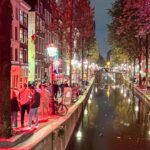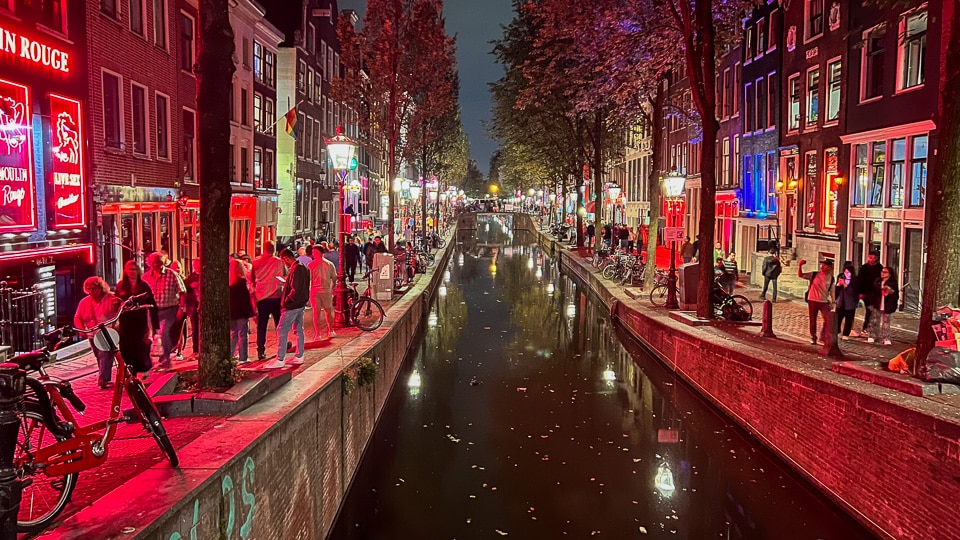
We've been to the city of Amsterdam many times, including on our very first time in Europe together in 1975. I'm not sure what first attracted us, but after spending a week there in September, I did some thinking about why I keep coming back. Yes, the Dutch capital's central area and its iconic canals is a UNESCO World Heritage Site. But that alone isn't the best reason to stop in Amsterdam.
Here's what I came up with: Amsterdam is an example of a progressive living philosophy with a backdrop of what seems like a movie set out of the 1600s.
The most obvious example of what I'm talking about is the liberal attitude about marijuana and prostitution, both of which are featured in the Red Light District, in the city center near the port and Amsterdam Centraal train station. Historically, it's where the sailors who manned the famous Dutch trading fleet which plied the world since the 15th Century hung out. Today, instead of sailors, it's tourists who fill the streets, ethnic restaurants, bars, and coffee shops (the euphemism for bars that allow smoking of cannabis, and also usually sell it.)
But what distinguishes this Amsterdam landmark neighborhood from seedy counterparts in other cities of the world is that said marijuana use and prostitution are wide open, obvious, and tightly regulated.
As a practical matter, that means the prostitutes are on display, usually behind a glass door, rather than walking and soliciting on one of the main streets in town (are you listening, Madrid?) And, they submit to regular medical exams, and have buttons that can summon the police if anything gets out of hand.
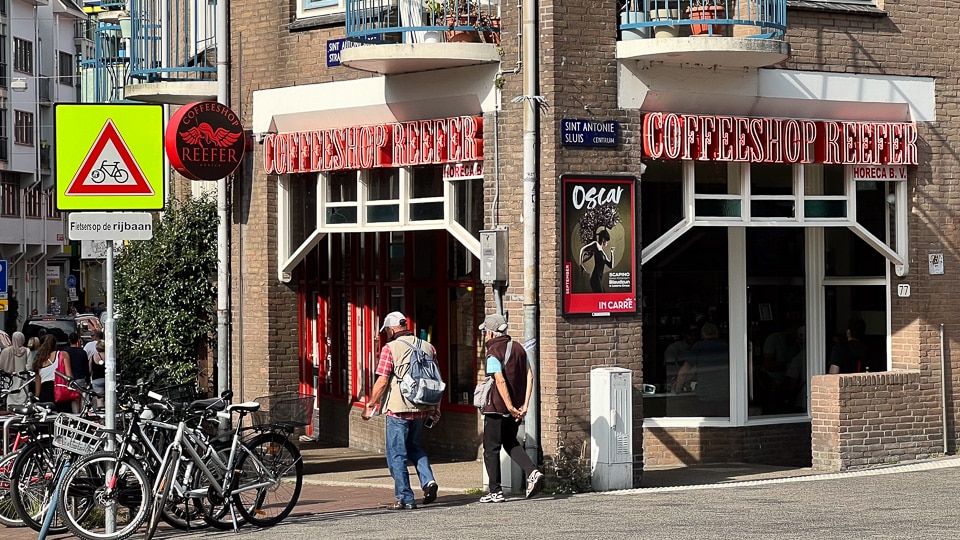
As for weed, although you'll often catch a whiff of its distinctive smoke, the only legal place to buy it and smoke it is in the regulated “coffee shops.” Which is really a good way to do it, if you ask me. If you're not interested, don't go in. Simple. (Be sure you know the difference between a café and a “coffee shop” or you could be in for a surprise.)
Add to the above the relative dearth of cars – Amsterdammers get around mostly on bikes, public transport, and walking. There are small ethnic restaurants and food stands in every neighborhood. Finally, you have flower markets, small local shops full of crafts and antiques, the dozens of art galleries lodged in the historic buildings and featuring everything from local plein air paintings to Picasso, and, of course, the world famous museums. All together, this makes Amsterdam one of the most interesting, welcoming, and easy to explore cities in the world.
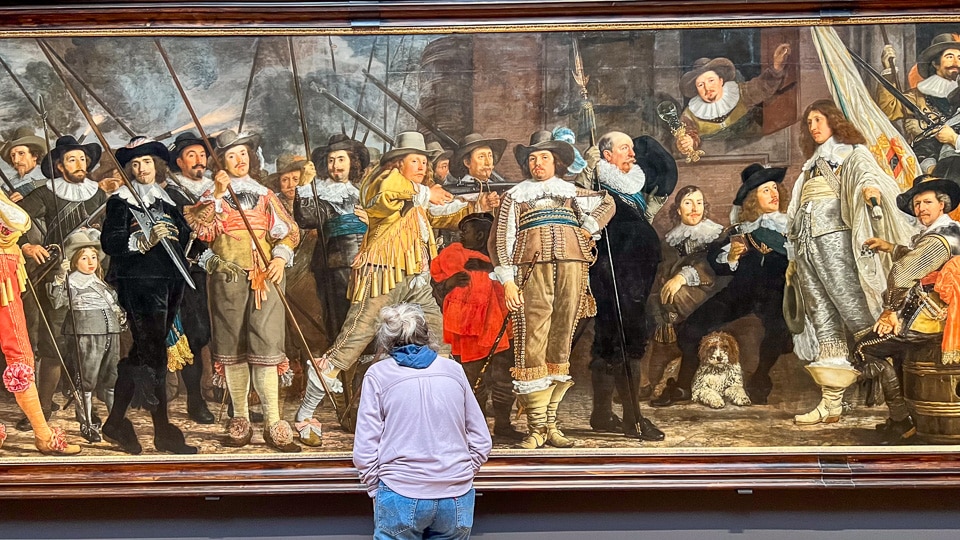
Amsterdam museums
The Rijksmuseum is the must-visit for anyone interested in Dutch art and history. Its collection spans 800 years, showcasing masterpieces from the Dutch Golden Age, including Rembrandt's The Night Watch, (unfortunately currently mostly behind some scaffolding while it's being restored) and the glimmering Isaac and Rebecca, The Milkmaid by Johannes Vermeer, a beautiful depiction of domestic life, and several by one of my favorites, Jan Steen, also depicting everyday life in Holland. In addition to the seminal works of the Dutch Masters, the museum also houses an impressive collection of decorative arts and historical artifacts, including some very detailed models of 17th Century sailing ships.
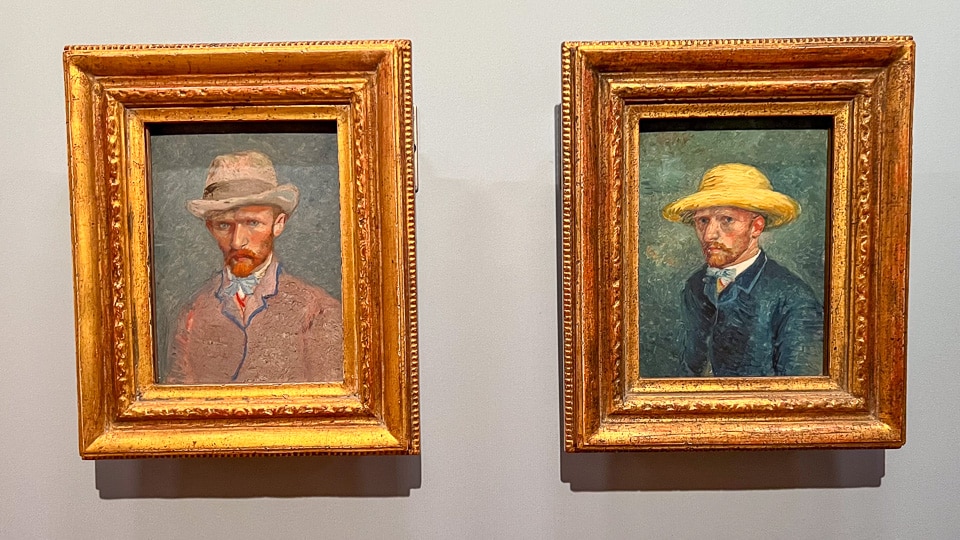
The Van Gogh Museum is home to the largest collection of works by Vincent van Gogh in the world, offering a deep dive into the life and evolving style of the artist. Among its treasures are Sunflowers, one of Van Gogh's most famous series, and The Bedroom, an intimate portrayal of his living quarters in Arles. The museum also offers insight into Van Gogh's personal struggles through excerpts from his letters and notebooks displayed along with the paintings.
For modern and contemporary art, the Stedelijk Museum features an extensive collection of 20th and 21st-century works, with pieces from iconic artists such as Piet Mondrian and Kazimir Malevich. Mondrian’s famous Composition with Red, Blue, and Yellow is a standout piece – the primary example of the abstract, geometric style of the De Stijl movement. The museum also features an extensive photography collection.
The MoCo Museum is known for its collection of modern, contemporary, and street art. The museum frequently features works from internationally renowned artists like Banksy, whose iconic Girl with Balloon and Laugh Now pieces are standout attractions. Add some Basquiat and you've got a combo that provokes your imagination. The museum also hosts rotating exhibitions from other influential contemporary artists, creating a vibrant, ever-evolving experience.
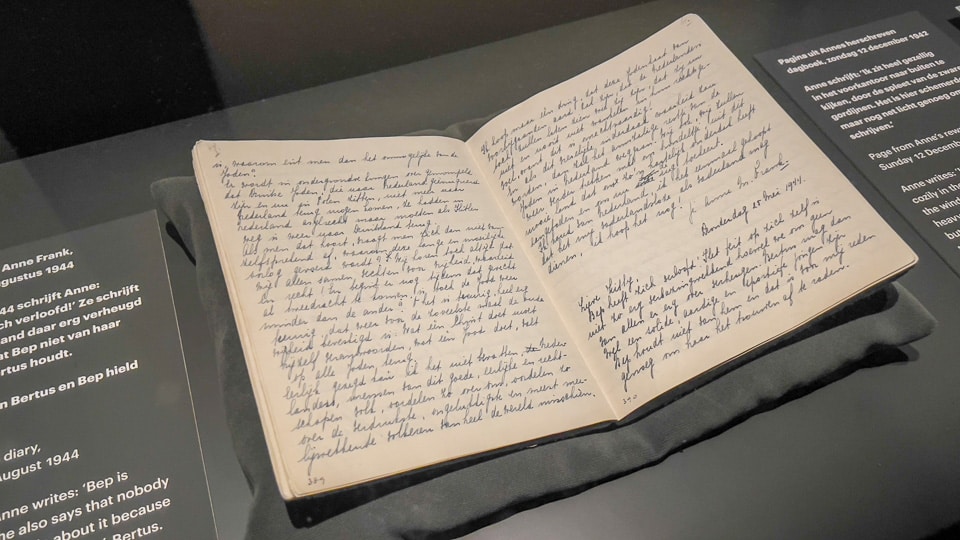
The Anne Frank House preserves the hidden annex where Anne Frank wrote her famous diary while hiding from the Nazis during World War II. Visitors can walk through the preserved rooms of the annex, gaining some insight into the Frank family’s struggle and the broader history of the Holocaust. The original books of Anne Frank's diary are on display and underscore the cost to the world of this very talented girl's horrible death in the concentration camps. The entries to Anne Frank's House sell out long in advance. You should make reservations five to six weeks in advance of your visit to Amsterdam. Tickets are €16.
The Dutch Resistance Museum (Verzetsmuseum) offers insight into the courage and resilience of the Dutch people during World War II and the German occupation and helps put the Anne Frank exhibit in more context. You are led through immersive exhibits that recount the stories of ordinary citizens who resisted Nazi occupation – from sabotage to hiding Jewish families. The museum, to its credit, also does not shy away from the stories of those who collaborated with the Germans.
Amsterdam restaurants I liked
Amsterdam features cuisine from everywhere in the world. Indonesian food (a happy legacy from Holland's colonial past) is perhaps the best overall, but the native bitterballen, herring, apple pie, stroopwaffels, mashed potatoes with lots of onions, and the Edam and Gouda cheeses are musts to try.
Here are some of the restaurants I enjoyed in Amsterdam.
Blushing, Paulus Potterstraat 30A, simple breakfast, delicious scrambled eggs, with salad and a coffee latte. Also a selection of smoothies. Very near the Hotel Aalders, where I stayed. Open for breakfast and lunch only.
At the Seafood Bar, I had a heaping (much more than I could eat) plateau of smoked fish, bread with a delicious herb butter, and a glass of tart Albariño – perfect with seafood. It came to €33. It was also an easy walk from the Aalders Hotel.
My first foray into the famous hearty Dutch cuisine was at The Pantry. Two beers, hutspot (mashed potatoes teeming with onions) with sausage, and an Appletaart for dessert came to €33.
Another famous spot for traditional cuisine is Cafe Luxembourg, where I had shrimp croquettes, a salad, two beers and a brandy, and a delightful conversation with the Dutch couple at the next table. Total: €34.50.
For the signature Indonesian meal, I chose Tashi Deleg, based on a friend's recommendation. It's actually billed as an Indonesian/Tibetan restaurant There, a friend and I shared the signature Indonesian Rijsttafel (literally rice table,) which included eight small dishes, eggroll, rice, etc. That came to about €80 for the two of us, with drinks and dessert.
The Foodhallen, or Food Hall, as the name suggests, is a large open space filled with about 20 different opportunities to taste, well, about 20 different things. I settled for two dishes, the highlight though was a felafel sandwich.
After all the rich food, I was very happy to run across the aptly named Lavinia Good Food. A lunch of a caprese toast with arugula was just what my overtaxed digestive system needed. With tea, about €20.
Along those healthy lines, I'm also glad I ran across TheSandwichShop (one word,) on the same street as the Hotel Luxer. Yogurt and fruit, or one of their smoothies make a great breakfast.
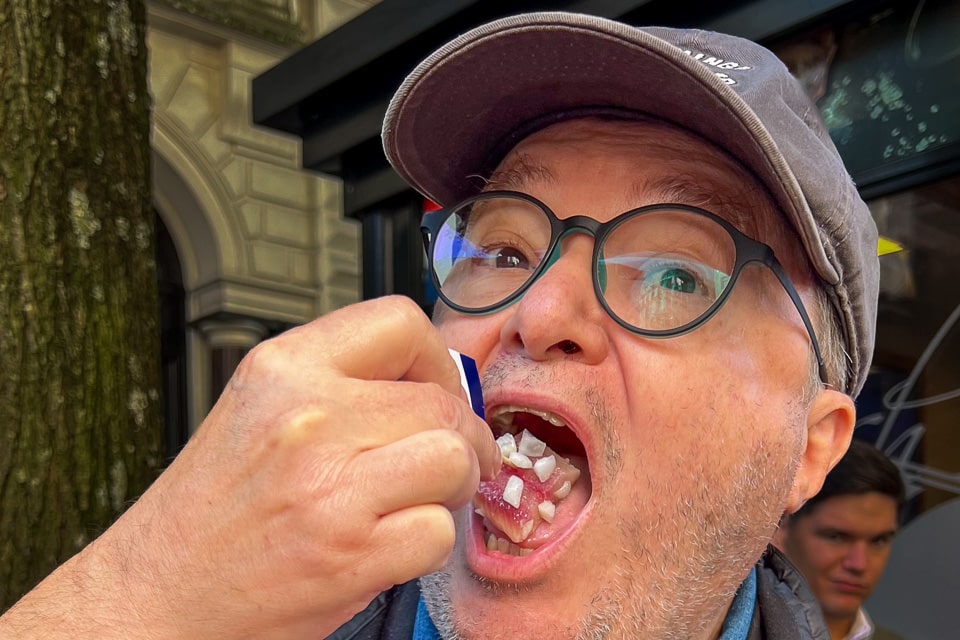
A good idea for sampling the traditional cuisine is to take a Devour food tour, which took us for a walk around Amsterdam for three hours and a sample of all of the above named tastes. We visited the Hans Egdort Bakkerij for Stroopwaffel, Café de Zwart, for Appeltaart, Jonk Volendammer, for salted herring and fried cod – the ultimate Amsterdam street food, and finally, the Wegewijs Cheese Shop for a plate of young, medium, aged, and truffle-infused Dutch cheeses.
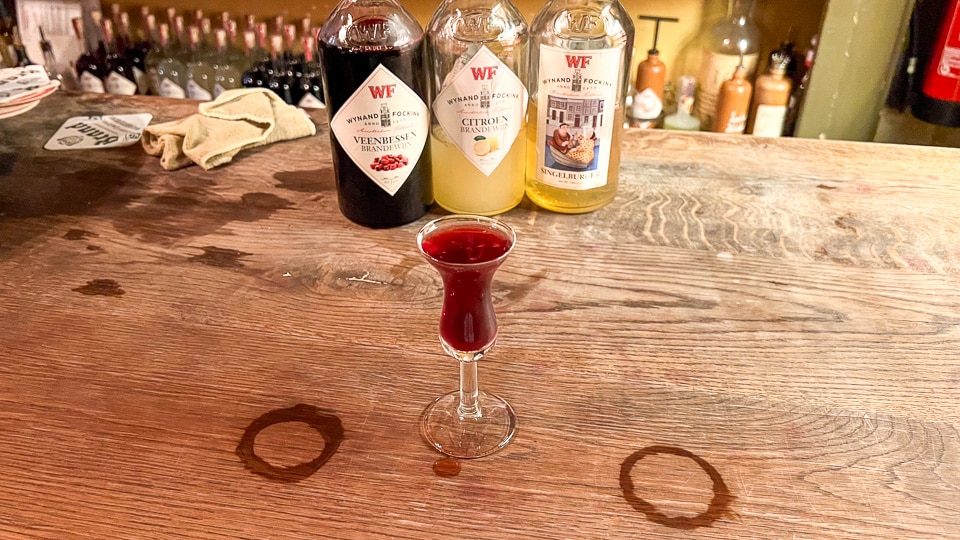
Finally, sometimes you just need a good, no-frills bar, and that is the iconic Wynand Fockink, near Dam Square. The bar, which is just about big enough for eight people to stand in, features about 80 jenevers and other spirits, and, more important, a crew of stellar bartenders who really know how to make a drink. In general, it goes something like this. The bartender doesn't really ask you what you want; they ask you how you're feeling. Are you happy, pensive, tired, exhilarated? And depending on your answer, that is what you'll get expertly poured into their distinctive glass until the surface tension of the liquid actually suspends the concoction over the brim. Then, you're expected not to pick up the glass, but rather “bow to the bar” and take your first sip from the glass on the bar. Only then, can you pick up the glass and savor the rest.
I visited Wynand Focking twice in my week, and tried eight different drinks. The alcohol content is way lower than you'd think, so four drinks in a night is not too much. The ones I got the recipes for were the “Little Bitch” for when I wanted something to wake me up a bit. That was a combo of lemon and ginger infused jenevers, with a smidge of cranberry to make it ever more tart. The other memorable one came after I'd just had dinner, and so I asked for something along the lines of a dessert. That request yielded a drink that started with tobacco bitters, angostura bitters, and then a rum-style jenever, and then separate jenevers infused with coffee and chocolate. Dessert indeed.
The atmosphere of Wynand Fockink is unique. You'll end up in conversations with the bartenders and the other customers that will make you want to stay as long as you like. But, unusual for a bar, Wynand Fockink closes promptly at 9 p.m. When I asked why, I was told, “We don't want a bunch of drunks in here.” I love that place. Honestly, it's probably my favorite bar in the world.
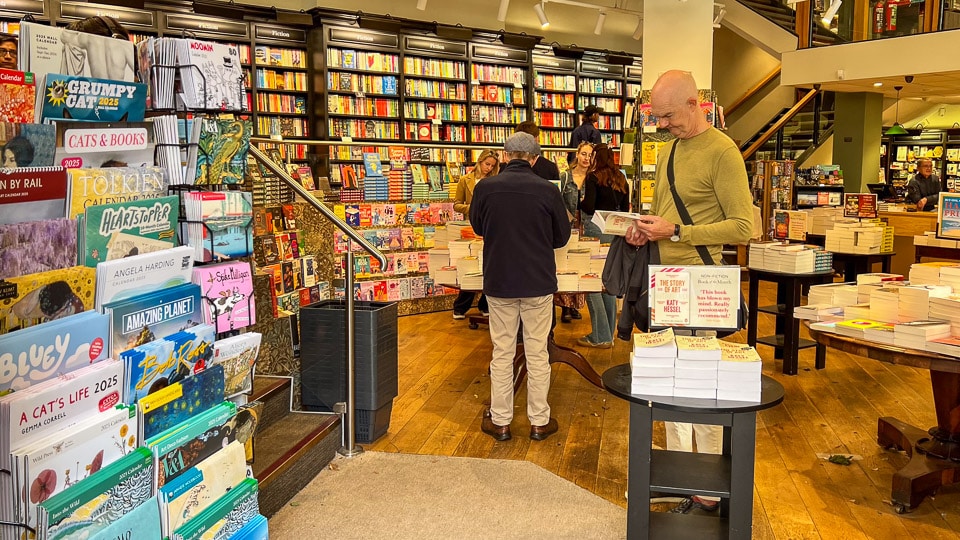
Other Amsterdam attractions
When walking around Amsterdam, the street level attractions are constant. I browsed everything from imaginative t-shirt shops, to candy stores, to Delft porcelain. My favorite street for shopping though was Nieuwe Spiegelstraat, which proceeds directly from the front of the Rijksmuseum and showcases dozens of top notch art galleries, antique shops, shops specializing in old maps, and more. Well worth a couple of hours poking around. My friend bought a Picasso lithograph.
Another pleasant surprise was stumbling upon Waterstones English bookstore, that can really fill the gap when you've just finished the book you brought with you. A great selection of both classical and popular fiction and non fiction.
Day Trips
The Netherlands boast an efficient train network that will take you anywhere quickly, although not necessarily cheaply.
I took two day trips on the excellent Dutch train system while I was staying in Amsterdam – to The Hague and Leiden, both times mostly to see their excellent museums.
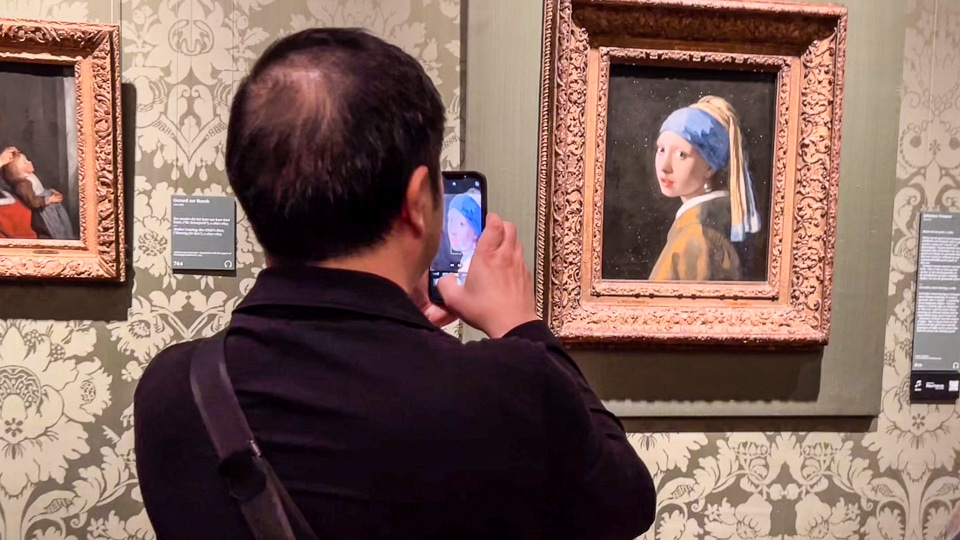
The train to The Hague cost €28.20 round trip, and took about 55 minutes, and another 15 minute walk to the small but highly significant Mauritshuis Museum. The Mauritshuis houses the “Royal Cabinet” collection of paintings and features Rembrandt, Franz Hals, Jan Steen, and Hans Holbein the Younger. But the highlights are Vermeer's famous Girl With the Pearl Earring and The Goldfinch by Carel Fabritius, which inspired one of my favorite books, Donna Tartt's The Goldfinch.
Another day, I took the train to Leiden (about 40 minutes and €22.20 round trip,) to kill some time and to meet some Dutch friends for dinner. Leiden is an historic city, and features the Pieterkirk, which was the church of the Pilgrims before they moved to America. But the real highlight of the visit was the SieboldHuis Japan Museum, which at the time was featuring two wonderful exhibits: Hokusai's famous Great Wave, complementing their already extraordinary collection of Japanese woodblock prints, and a Kimono exhibit featuring 20th Century designs. Also, the museum encompasses a private shop where you can buy actual Japanese prints.
In case you go to Leiden, I highly recommend dinner at Waag. Make a meal out of the delectable small plates, which are mostly a modern take on traditional Dutch cuisine.
Hotels I stayed in
I split my stay in Amsterdam between two hotels, and both had their charms.
After I arrived at the Amsterdam airport, I took the advice that the Aalders Hotel kindly sent me to take the 397 bus into the city from right in front of the airport, which let me off about a block from the hotel. The bus cost €6.50, which you can pay by touching your credit card as you enter and exit the bus. As I was checking in, another American couple arrived from the airport via taxi, which they said cost them €75. I'm so glad I read the hotel's email.
The Aalders is what I'd call a boutique hotel, with a quaint curving stairway leading up to my first floor room. An elevator was available, too, which I used when I was carrying my luggage. The room was quite small and I had to do a bit of squeezing to get around the bed, but the room was adequate with a nice bathroom, a desk, and a luggage rack and wardrobe for my gear. They also had a very nice European style breakfast of eggs and bacon, cured meats and cheeses, yogurt and fruit, and nice pastries for a charge of €15. Worth it, I'd say.
The Aalders, by the way, is located about two blocks from the Rijksmuseum on a quiet street mostly featuring similar hotels. There are a few restaurants recommended by the hotel within easy walking distance.
After a few days, I moved closer to the “action” to the Hotel Luxer, nearer the central train station, and more or less on the edge of the Red Light District. The Luxer's room was much the same as the Aalders, on the small side, but comfortable and well insulated from the somewhat noisier street. The Luxer's breakfast was minimal, a basket of absolutely some of the best croissants I've ever had outside Paris, and a coffee machine. The nice feature was that the breakfast was free.
Up Your Travel Skills
Looking to book your next trip? Use these resources that are tried and tested by us. First, to get our best travel tips, sign up for our email newsletter. Then, be sure to start your reading with our Resources Page where we highlight all the great travel companies and products that we trust. Travel Accessories: Check out our list of all the accessories we carry to make getting there and being there a lot easier. Credit Cards: See our detailed post on how to choose the right travel rewards credit card for you. Flights: Start finding the very best flight deals by subscribing to Thrifty Traveler. Book your Hotel: Find the best prices on hotels with Booking.com. See all of the gear and books we like in one place on our Amazon shop.Got a comment on this post? Join the conversation on Facebook, Instagram, or Threads and share your thoughts!

